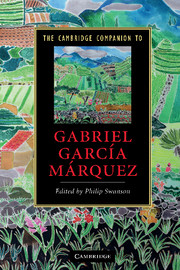Book contents
- Frontmatter
- Introduction
- 1 Gabriel García Márquez: life and times
- 2 The critical reception of García Márquez
- 3 Before One Hundred Years of Solitude: the early novels
- 4 One Hundred Years of Solitude
- 5 An eco-critical reading of One Hundred Years of Solitude
- 6 The Autumn of the Patriarch
- 7 The General in His Labyrinth
- 8 García Márquez’s novels of love
- 9 García Márquez’s short stories
- 10 García Márquez’s non-fiction works
- 11 García Márquez and film
- 12 García Márquez, magical realism and world literature
- Further reading
- Index
1 - Gabriel García Márquez: life and times
Published online by Cambridge University Press: 28 September 2010
- Frontmatter
- Introduction
- 1 Gabriel García Márquez: life and times
- 2 The critical reception of García Márquez
- 3 Before One Hundred Years of Solitude: the early novels
- 4 One Hundred Years of Solitude
- 5 An eco-critical reading of One Hundred Years of Solitude
- 6 The Autumn of the Patriarch
- 7 The General in His Labyrinth
- 8 García Márquez’s novels of love
- 9 García Márquez’s short stories
- 10 García Márquez’s non-fiction works
- 11 García Márquez and film
- 12 García Márquez, magical realism and world literature
- Further reading
- Index
Summary
Gabriel García Márquez was born on 7 March 1927 in the dusty small town of Aracataca, some 80 kilometres (50 miles) from Colombia's Caribbean shore. For some decades hence, and for reasons unknown, he had mistakenly given his birth date as 1928. Owing to family conflicts, 'Gabito' (his childhood nickname) was at first raised by his maternal grandparents, Colonel Nicolás Márquez and Tranquilina Iguarán. The grandfather was an imposing figure. A hero on the Liberal side in Colombia's 1899-1902 civil war, he was also a natty dresser with fine manners, who served a term as Aracataca's mayor. In addition, he was an excellent paternal surrogate, teaching the boy to use the dictionary, telling him war stories and leading him by the hand hither and yon about town. For his first nine years, Gabito grew up in a loving household, surrounded by aunts who encouraged his curiosity and storytelling bent. They filled his mind with much of the folklore and family lore that eventually enriched his fiction. In Aracataca he attended the local Montessori school, learning to see and examine with discipline. It was the only elementary institution that he would recall with great affection. At age nine, Gabito went to live with his parents in the town of Sincé. (Grandpa Nicolás passed away a short while later.) The boy scarcely knew the couple. His birth, in fact, had been the culmination of a long chain of events.
- Type
- Chapter
- Information
- The Cambridge Companion to Gabriel García Márquez , pp. 7 - 24Publisher: Cambridge University PressPrint publication year: 2010
- 2
- Cited by



